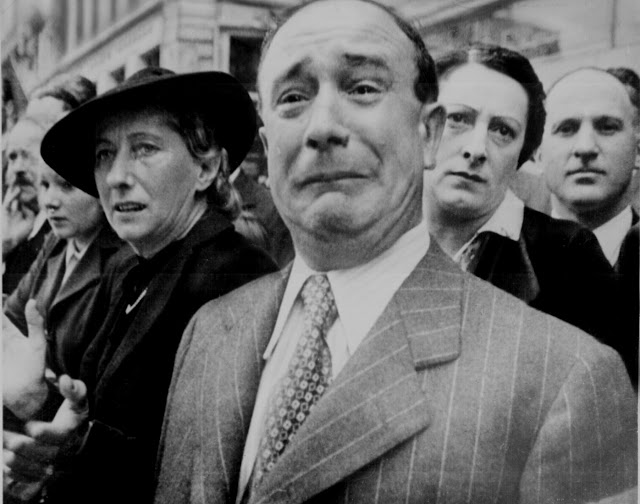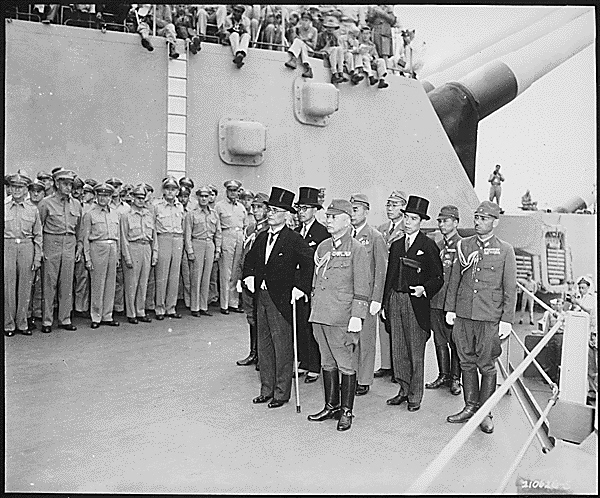World War 2 (often abbreviated WWII or WW2) was a global military conflict which involved a majority of the world's nations, including all of the great powers, organized into two opposing military alliances: the Allies and the Axis. The war involved the mobilization of over 100 million military personnel, making it the most widespread war in history. The start of the war is generally held to be in September 1939 with the German invasion of Poland and subsequent declarations of war on Germany by the United Kingdom, France and the British Dominions. The Soviet Union and the United States emerged from the war as the world's leading superpowers. The self determination spawned by the war accelerated decolonisation movements in Asia and Africa, while Western Europe itself began moving toward integration.In the aftermath of World War I, a defeated Germany signed the Treaty of Versailles. This worried France and the United Kingdom, who had lost much in the previous war, as well as Italy, which saw its territorial ambitions threatened by those of Germany. Hoping to contain Germany, the United Kingdom, France and Italy formed the Stresa Front.
This may be a famous photo to see the history of world war 2 :
This may be a famous photo to see the history of world war 2 :
Frenchman crying - June, 1940
This famous is a picture of a middle-aged man who cried, He cried when he watched the French troops leave Toulon to Africa, perhaps to fight the Nazis. The glory of France has been destroyed by Hitler's legions. In a matter of weeks, the pride of the French army, the Maginot Line, and all the pride of France was destroyed by Nazi blitzkreig. He is a middle-aged man, probably in his mid forties. you could see the tears, tie, jacket is good. He survived the World War one and still looks good and healthy. And now? dark skies over France had come, and soon, the whole of Europe. She cried for Twentieth Century.
Churchill Portrait - by Yousuf Karsh, 1941
This famous photograph is a picture of Winston Churchill. He was a fearsome warlord who is very bleak bulldog of a rebel. "We will not give up." in say he thinks I sometimes wonder if the enemies of democracy and freedom of modern English language to understand Churchill and Roosevelt. Winston Churchill's famous photograph was taken by Yousuf Karsh. It was in 1941, in Ottawa, in Churchill's speech in the House of Commons. King Prime Minister arranged for a portrait session in the Speaker's room. Nobody told Churchill in this photo session, so after a lit cigar he growled, Karsh "Why am I not informed about this?" Churchill then asked to remove the cigar for portrait photography. When Churchill refused, Karsh, then 33, walked into a great man, said, "Excuse me, sir," and calmly grabbed the cigar from Churchill's lips. As Churchill glared into the camera, Karsh snapped the picture. Karsh considers that the picture is one of your favorite photos.
Smoking battleships at Pearl Harbor - December 7, 1941
This is the famous photo at the Japanese attack on Pearl Harbor, USS Tennessee (BB-43) is a ship of sunken warships. Note extensive distortion lower midships superstructure West Virginia, caused by torpedoes that exploded below that location. Also note 5 "/ 25 gun, still partially covered with canvas, boat crane swung outboard and empty boat cradles near the smokestacks, and base radar antenna above the foremast West Virginia.
Lexington at the Coral Sea - May 7, 1942
This famous photo is the aircraft carrier that was hit by a torpedo, the first naval engagement in history fought without the opponent ships making contact, U.S. carrier forces stopped the Japanese landing at Port Moresby. The Japanese lost the light carrier Shoho and the U.S. lost the carrier, the USS Lexington (CV 2). Task Force 17 with the carrier USS Yorktown (CV 5), bombed Japanese transport involved in landing troops in Tulagi Harbor, damaging several and sinking one destroyer. They were later joined by other Allied naval units including Task Force 11 with USS Lexington (CV 2). On 7 May, the aircraft carriers located and sank the light carrier Shoho. Simultaneously, the Japanese attacked task Force 17, scoring hits on Yorktown. Lexington was hit by a torpedo. Lexington lights on, the fire shot hundreds of feet into the air.
Jewish boy raising his hands, in the Warsaw Ghetto - May, 1943
One of the most enduring images of the Holocaust, showing German storm troopers forcing Warsaw ghetto dwellers to move with their hands up. The Jews of the Warsaw Ghetto staged one of the few rebellions against Nazi rule in April and May, 1943.
Eisenhower with airborne troops before D-Day - June 5, 1944
General Dwight Eisenhower, "Ike," Supreme Commander of Allied Forces in Europe, speaks to the young soldiers of the 101st Airborne, on the eve of D-Day. "Some of the men with Gen Eisenhower are presumed to be: Pfc William Boyle, Cpl Hans Sannes, Pfc Ralph Pombano, Pfc S. W. Jackson, Sgt Delbert Williams, Cpl William E Hayes, Pfc Henry Fuller, Pfc Michael Babich. and Pfc W William Noll. The determined troopers, faces blackened, listen attentively.
Soldier going ashore on D-Day, - by Robert Capa, June 6, 1944
At 6:31 a.m. Robert Capa landed in the first wave on Omaha Beach. Capa described the morning, "After the pre-invasion breakfast at 3 am with hot cakes, sausages, eggs and coffee, served on the invasion ship by white-coated waiters, at 4 am the invasion barges were lowered down into the rough sea. The men from my barge waded in the water. There a darkroom technician, eager for glimpses of the landing, dried the film too fast. The soldier in the picture has been identified as Huston Sears Riley.
German Soldier - 1944?
Serving one of the most evil regimes ever seen on Earth, the individual German soldier was renowned for his battlefield skills, dedication, and ingenuity. The individual soldier is unknown (at least to me), taken in France in the winter of 1944-45, although I originally assumed it was from the Russian Front, the classic image of the cold and worn-out German soldaten, "Winter Fritz."
MacArthur wading ashore in the Philippines - by Carl Mydans, October 1944
On October 20, 1944, a few hours after his troops landed, MacArthur waded ashore onto the Philippine island of Leyte. Carl Mydans of Life took the dramatic photograph of General Douglas MacArthur and staff coming ashore at Lingayen Gulf, Luzon, in the Philippines on January 9, 1945. MacArthur was commander of the United States forces in the Pacific. When the United States lost the Philippines, he promised to return. Here’s Mydans’ description of that event: "Luck is forever at play in a photographer’s life. When it did, it dropped its ramp in knee-deep water, and I photographed MacArthur wading ashore.
Flag Raising at Iwo Jima - by Joe Rosenthal, February 1945
The editors spotted it instantly as a moving, memorable image, of American resolve, tenacity, and victory. As soon as Mount Suribachi had been somewhat secured, some Marines raised a flag. Six Marines (Doc Bradley, Mike Strank, Rene Gagnon, Harlon Block, Ira Hayes, and Franklin Sousley) were assigned to put up the larger flag. Photographer Joe Rosenthal went along. The flag-raising party made it to the top without incident, and Rosenthal caught the famous image, quite hastily, as he had been distracted moments before the famous event. His original caption: "Atop 550-foot Suribachi Yama, the volcano at the southwest tip of Iwo Jima, Marines of the Second Battalion, 28th Regiment, Fifth Division, hoist the Stars and Stripes, signaling the capture of this key position.
Flag Raising over the Reichstag - by cameraman Khaldei, May, 1945
Stepan Andreyevich Neustroyev commanded the battalion that stormed the Reichstag in 1945 and hoisted the flag over the building. Photographer Khaldei had made the flag in the photograph himself from red tablecloths from Tass, the Soviet press agency, emblazoned with the Soviet hammer and sickle. Erich Kuby's book The Russians and Berlin, page 60, says:
Mednikov describes this historic action in great detail:
At 10:50 p.m. on April 30, the banner of victory was unfurled over the Reichstag."
Mednikov describes this historic action in great detail:
At 10:50 p.m. on April 30, the banner of victory was unfurled over the Reichstag."
Sailor kissing girl in Times Square - by Alfred Eisenstaedt, V-J Day, 1945
Alfred Eisenstaedt of LIFE took the photograph of a sailor kissing a nurse at the Times Square celebration on August 15, 1945, at the end of World War II. On the 50th anniversary of the photograph, the couple was identified as Edith Shain and Carl Muscarello.
Surrender on USS Missouri - Sept. 2, 1945
The short second paragraph went straight to the heart of the matter: "We hereby proclaim the unconditional surrender to the Allied Powers of the Japanese Imperial General Headquarters and of all Japanese armed forces and all armed forces under Japanese control wherever situated. Overhead, a thousand American F4U Corsairs and F6F Hellcats roared over. What had started at Pearl Harbor had been finished.

 Privacy Policy
Privacy Policy RSS
RSS Sitemaps
Sitemaps facebook
facebook twitter
twitter






















